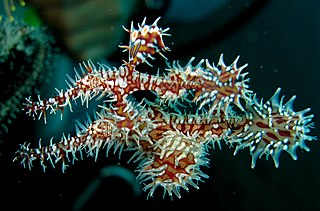
Solenostomus, also known as ghost pipefishes, false pipefishes or tubemouth fishes, is a genus of fishes in the order Syngnathiformes. Solenostomus is the only genus in the family Solenostomidae, and includes six currently recognized species. Ghostpipefishes are related to pipefishes and seahorses. They are found in tropical waters of the Indo-Pacific.

Corythoichthys is a genus of pipefishes of the family Syngnathidae. All species in the genus are found in the tropical Indian and Pacific Oceans on reefs or rubble bottoms. Relationships and taxonomy within the genus are still in debate, but there may be at least 23 species.
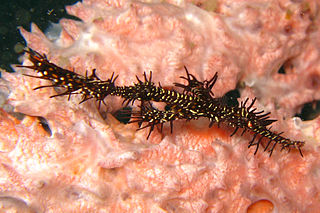
The ornate ghost pipefish or harlequin ghost pipefish, Solenostomus paradoxus, is a false pipefish of the family Solenostomidae. The species name comes from the Greek paradoxos, referring to this fish's unusual external features. Ornate ghost pipefish are found in the Western Pacific and the Indian Ocean along reef edges prone to strong currents from the Red Sea to Tonga. They reach a maximum length of 12 cm. They vary in color from red or yellow to black and are almost transparent. Although relatively common, ornate ghost pipefish are very well-camouflaged and difficult to find. It occurs either as solitary individuals or in pairs, among the branches of gorgonians, in floating weeds, or crinoids where the feed on mysids and small benthic shrimp.

The Fungiidae are a family of Cnidaria, often known as plate corals. The family contains thirteen extant genera. They range from solitary corals to colonial species. Some genera such as Cycloseris and Fungia are solitary organisms, Polyphyllia consists of a single organism with multiple mouths, and Ctenactis and Herpolitha might be considered as solitary organisms with multiple mouths or a colony of individuals, each with its separate mouth.

The messmate pipefish is a species of marine fish in the family Syngnathidae. It is widespread throughout the tropical waters of the Indo-Pacific region, from the eastern coast of Africa to the Vanuatu Islands. This species can reach a length of 19.8 cm. It occasionally makes its way into the aquarium trade where it is known as the dragonfaced pipefish. Other common names are bloodspot pipefish, reef pipefish, reeftop pipefish and yellow-streaked pipefish.
Doryrhamphus janssi, commonly known as the Janss' pipefish , is a species of pipefish belonging to the family Syngnathidae.

Corythoichthys intestinalis, known commonly as the scribbled pipefish, is a species of marine fish in the family Syngnathidae. Other common names used include banded pipefish, Australian banded pipefish, Australian messmate pipefish and messmate pipefish.
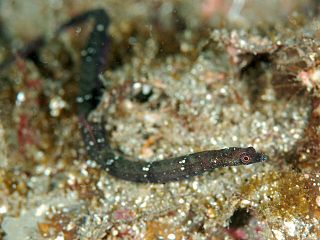
Halicampus is a genus of pipefishes of the family Syngnathidae, containing 12 described species.

Acentronura is a genus of pygmy pipehorse native to the Indian and Pacific oceans. The name is derived from the Greek ακεντρονουρα, or a-kentron-oura, and refers to the lack of a sting on the tail.
The long-tailed ghost pipefish or armored ghost pipefish(Solenostomus armatus) is a ghost pipefish in the family Solenostomidae. The species name comes from the Greek armatura, referring to this fish's armor of dermal plates. Solenostomus leptosoma is now considered a synonym of S. armatus, the valid species identification.

The robust ghost pipefish, also known as the blue-finned ghost pipefish, Racek's ghost pipefish, robust-snouted ghost pipefish or the squaretail ghost-pipefish, is a species of false pipefishes belonging to the family Solenostomidae.

The Halimeda ghost pipefish, Solenostomus halimeda, is a species of false pipefishes belonging to the family Solenostomidae.
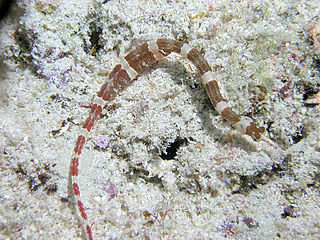
Corythoichthys amplexus, known commonly as the brown-banded pipefish, is a species of marine fish in the family Syngnathidae.

Doryrhamphus excisus is a species of flagtail pipefish from the genus Doryrhamphus. Its common names include blue-striped pipefish and blue-and-orange cleaner pipefish. The fish is found throughout much of the Indo-Pacific and tropical East Pacific.
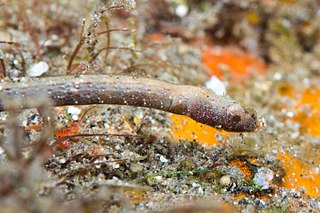
Halicampus dunckeri or also commonly known as the Duncker's pipefish or ridgenose pipefish is a species of fish in the family Syngnathidae.
Bhanotia fasciolata is a marine fish of the family Syngnathidae. It is found in coral reefs, tidepools, and muddy/silty substrates in the Eastern Indian Ocean and Western Pacific. It inhabits at a depth range of 3–25 metres (9.8–82.0 ft), where it can grow up to 9 centimetres (3.5 in). It is ovoviviparous, with the male carrying the eggs in a brood pouch until they are ready to hatch.

Doryrhamphus negrosensis, commonly known as Negros pipefish, flagtail pipefish, Masthead Island pipefish or Queensland flagtail pipefish, is a species of marine fish of the family Syngnathidae. It is found in the Western Pacific Ocean, from Borneo to Vanuatu and the Yaeyama Islands to the Rowley Shoals and the Great Barrier Reef. It lives in mud flats and reefs, both coral and rocky, where it is often associated with sea urchins. It is a rather solitary species which may be found in pairs or small groups. It inhabits depths to 9 metres (30 ft), and can grow to lengths of 6.2 centimetres (2.4 in). Although little is known of its feeding habits, it is expected to feed on harpacticoid copepods, gammarid shrimps, and mysids, similar to other pipefish, it may also act as a cleaner fish like other species in the genus Doryrhamphus. This species is ovoviviparous, with males carrying eggs before giving birth to live young. Males may brood at 4.3 cm. It is a small bluish to bluish-grey pipefish which has a pale stripe along the dorsal side of the head and snout, and a dark fan-like caudal fin which has white margins and an orange base.

Syngnathoidea is a superfamily of the pipefish and dragonet order Syngnathiformes. It is divided into two families – the speciose pipefish Syngnathidae, which includes the sea horses and the ghost pipefish, Solenostomidae, which has just five species. The superfamily occurs worldwide in tropical, subtropical and temperate seas, especially in coastal waters around rock and coral reefs and among sea weed and sea grass beds .There are, however, also some pelagic species of pipefish and even freshwater species. In total the superfamily comprises in excess of 50 genera and nearly 300 species.

Solenostomus paegnius, the roughsnout ghost pipefish is a species of ghost pipefish from the family Solenostomidae. It is an Indo-Pacific species which occurs from the Red Sea east to Japan and Australia. It occurs over algal/rubble reefs and sandy sea beds, often below depths of 10 metres (33 ft) They are largely pelagic until they settle on the substrate to breed.

The Southwest Indian Seamounts Marine Protected Area is an offshore conservation region in the exclusive economic zone of South Africa

















